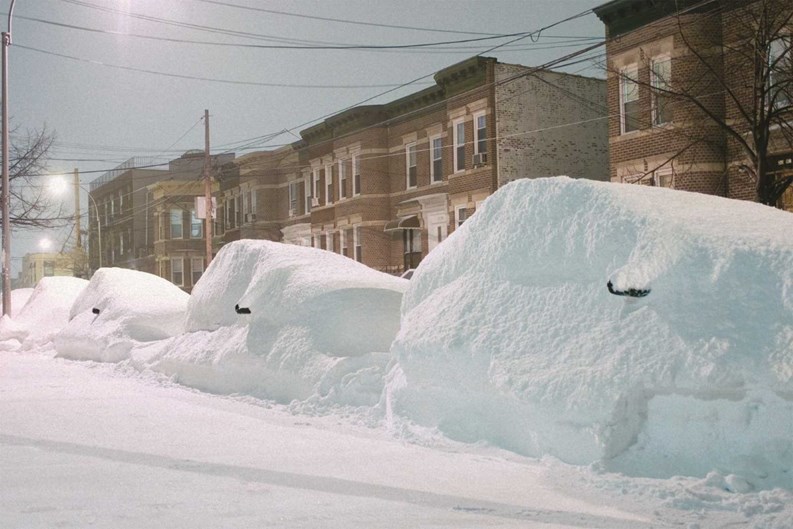Though the last couple of winters have been unusually mild, New York City does in fact get slammed with the occasional blizzard or ice storm—and when it does, the heavy snow and freezing temperatures inflict lots of wear-and-tear on co-op or condo buildings. Additionally, snow and ice coat sidewalks and curbs, creating headaches and potential hazards for buildings and associations.
Every building community needs to have a plan in place to deal with snow and ice issues, and almost 100 percent of the time, that means hiring a snow removal company to come and do the job in a timely manner. But even that isn’t always enough. A building must be sure that its staff is also prepared to deal with snowy/icy conditions, because slips-and-falls not only result in injuries (which of course nobody wants), but also lawsuits—and those can be very, very expensive, regardless of who wins.
Snow Go
“Building owners can remove snow themselves, or they can hire a superintendent or maintenance company to provide this service,” says R. J. Panda, property manager for Manhattan-based Fenwick Keats Management, Inc. “All owners and management companies should push for sidewalks and front steps to be cleared as soon as possible to prevent slip-and-fall hazards for residents and visitors.”
New York City sanitation code dictates that building owners are responsible to clear snow and ice from sidewalks and gutters within four hours after snow has stopped falling, or by 11 a.m. if the snow stopped falling after 9 p.m. the night preceding. According to the New York City Department of Sanitation (DSNY), if snow or rain freezes and becomes too difficult to remove, an alternative is spreading cat litter (clean and unused, of course!), salt, sand, sawdust or a similar appropriate material within the time guidelines. However, the best option is to clear the ice or snow, and spread salt (or similar ice melt) to prevent refreezing.
According to Peter Lehr, director of property management at Kaled Management Corporation with offices in Long Island and New York City, it’s important to have a sound snow and ice policy in place so everyone on the staff knows their role in helping to clean up after a storm. “It’s not just about shoveling the sidewalks, but you have to ensure that the interiors by the door, and common areas where people are walking are also safe for residents,” he says. “Staff must put down proper snow mats and take other precautions against anyone getting hurt.”
Snow Tech
While your co-op or condo's on-site staff may be quite capable of managing mild-to-moderate snow and icefall, bigger and more sustained storms may require some professional assistance to clean up. Choosing which service provider to go with depends on where your building or association is located, its size, and the complexity of its grounds and landscaping. According to Barry Grummer, president of Manhattan-based K Restoration & Roofing Corp. (KR&R), “There are many pitfalls to working in the winter, and a...less experienced contractor can easily get into serious problems. A company must have the logistics, insurance, expertise and equipment to be effective and profitable in winter work.”
A good place to start is to check if a prospective company is a member in good standing of a professional organization, such as the Snow & Ice Management Association or the Accredited Snow Contractors Association, which provides them the latest industry standards as well as training to keep them up to date.
Chris Marino, president of Xtreme Snow Pros, which works on condo developments throughout the tri-state area, says with technological advancements in software, equipment and supplies, the ability of removal companies to service even very large or landscaped communities has grown by leaps and bounds.
“Today there is new equipment that greatly increases the production level of getting the job done and getting it done better,” he says. “Through the use of liquids and new treated salt, the effectiveness of ice melt has increased. You can pre-apply some liquids to a property days in advance of a predicted snowfall, and know that the property will have complete coverage as soon as the first flake falls. Tie this in with software that allows us to dispatch and monitor site conditions live, and store all this data in case the client ever experiences a slip-and-fall.”
Grummer says that his firm also approached the almost continuous 2013-14 snowfall with new technology. “In winter environments, our crews use heating blankets to warm the work areas. Several vendors have these products, and they come in various sizes just like tarps. We create heated areas with these tarps in order to work when the weather is trying to stop us.”
When snow is in the forecast, the company applies anti-icing calcium chloride on the sidewalks before the storm hits and also uses liquid anti-icing and de-icing products to prep the work areas and sidewalks.
Be Prepared
While some might think that city crews will automatically appear and remove snow from the streets and sidewalks surrounding their building, that's not necessarily the case. The protocol all depends on the type of multifamily property in question. “In a vertical community, such as an apartment building in New York City, there is no interaction between city crews and private contractors,” Lehr says. “However, in residential communities consisting of a mixture of public and private streets—such as a gated community or planned unit development, for example—municipalities may be responsible for a main artery deeded to the municipality, while the homeowners association is required to maintain private roads off the main street.”
According to Panda, each building is responsible to make sure the exterior walkways of the property are free of snow and ice. He adds that many superintendents help the
City’s efforts—and maintain the building’s safety—by clearing snow in front of fire hydrants on the street as well.
One thing all snow pros agree on: you don’t want to wait until the weather reports get bad, or worse yet the snow is already falling, to get your building prepared for a severe winter weather event. Forewarned is forarmed, and it's never too soon to have your supplies, equipment, and contractors ready to deploy.
“The best time of year to stock up on melting agent is in early September for best pricing and for supplies,” Lehr says. “By Labor Day, we recommend that superintendents and building staff check that their snow blowers and other equipment used for snow removal are in working order.”
Panda recommends getting things ready in late summer or early fall, well before the threat of any snow. That way, “You don’t want to be caught off guard with an early fall snowstorm and without the necessary tools and supplies,” he says. “Remember that prices increase with demand, so costs will be much higher if you opt to purchase at the height of a snowstorm. Be prepared and take care of these tasks before the winter season.”
While he is a proponent of supporting local hardware stores, Panda says wholesale hardware companies offer great deals to purchase ice melt and other winter supplies in bulk at the beginning of the season, so building owners and managers should consider all options. He also feels a building should create a seasonal checklist and complete this maintenance/preparation with building staff members and applicable contractors each year.
As last winter proved that the product supply isn’t unlimited, so a savvy management company or building should store a winter’s worth of ice melt if they have the storage space to accommodate it.
“I would also like to think they should have their equipment in full working order by October 1st," says Marino. “Everyone needs to keep in mind that our winters have started a lot earlier for the past three seasons, so anything is possible.”
Going Pro
Most condos—particularly those in more suburban areas outside Manhattan and the denser parts of Brooklyn—have some sort of deal in place with a snow removal company, but depending on the terms of the contract, the service provider might only take action when the snow or ice is really bad.
Marino says that by hiring a professional snow and ice contractor, you are bringing in experienced snow and ice management that isn’t simply aesthetic; more than anything it is about safety. And when you hire someone to manage your property throughout the winter and any inclement weather that comes your way, it’s their job to understand all the risks and help nip those hazards in the bud before anyone gets hurt.
“A good contractor will perform a full assessment of your property before severe weather hits and alert you of any potential hazards that could become a real issue when there’s snow or ice on the ground,” he says. “Then, of course they remain vigilant once winter sets in to ensure that those areas and the rest of the grounds are safe and clear of snow and ice.”
All the contractors interviewed agree that a well-detailed contract that goes into what the client can expect from the service is crucial; the stakes are simply too high to leave things up to chance, or the possibility of misunderstanding.
“The client has to make sure they are being fully covered with clear definitions of when the contractor starts and ends service and when they apply ice melt,” Marino says. “If this is not clear, the client can be assuming responsibility without even realizing it.”
Monthly contracts with maintenance contractors have historically been structured with a flat monthly fee for all snow/ice removal per the city's sanitation guidelines. However, Panda believes that with the significant snowfall seen over the past two years, the structure will most likely change to include “up to X number of storms” or some other fee structure which allows additional billing for seasons with heavy snowfall.
“If the building has a parking lot that needs to be cleared, that is generally handled on a per occurrence basis,” Lehr says. “In a residential community setting, however, which usually entails a mixture of public and private roads, the HOA’s management company usually enters into a seasonal contract at a fixed monthly rate for snow clearing that would only be affected if snow needs to be trucked off site.”
Depending on the type of building, Lehr believes that co-op or condo staff should be equipped to handle clearing of up to six inches of snow. “They should be aware of weather forecasts and plan ahead if a substantial or prolonged snowfall is forecast,” he says. “For building personnel, the ongoing focus should be kept on melt issues after the initial clearing. Building personnel need to be vigilant in keeping an eye on melt conditions to prevent re-freeze resulting in black ice, slippery sidewalks and other hazards.”
Panda adds that building staff should make sure to keep all walkways clear and salted/sanded in between contractor visits. He cautions that snow cannot be cleared into the street or in front of fire hydrants as this practice is against the law and can result in fines from the city.
Insurance Matters
Despite building staff and contractors' best efforts, the fact is that slip-and-fall cases are very common. To protect themselves and their communities from what can be very costly claims, boards and management should be acutely aware of the need for adequate insurance coverage.
“We keep an insurance consultant on retainer, and offer our clients an annual review of their insurance coverage before the renewal of a commercial policy,” Panda says. “This is a great benefit to building owners and an essential step to ensuring a building is properly insured.”
Elizabeth Sullivan, vice president of E.G. Bowman Company in Manhattan says if someone slips and falls due to a co-op or condo's negligence in not clearing snow and ice, the building could be financially impacted by resulting lawsuits and medical bills.
“Buildings should have general liability, which would provide coverage for both personal injury and property damage to third parties as a result of the building’s negligence,” she says. “We would also recommend an umbrella policy, which would respond in the event the primary GL policy limits were absorbed.”
In the final analysis, staying on top of snow and ice removal isn't about aesthetics, avoiding lawsuits, or even just complying with the law; it's about preventing injuries to residents, staff, and anyone who happens to be walking on your property. “There’s nothing more important than the safety of residents and workers in and around the building,” Lehr says. “Just be sure to do it right.”
Keith Loria is a freelance writer and frequent contributor to The Cooperator.







Leave a Comment